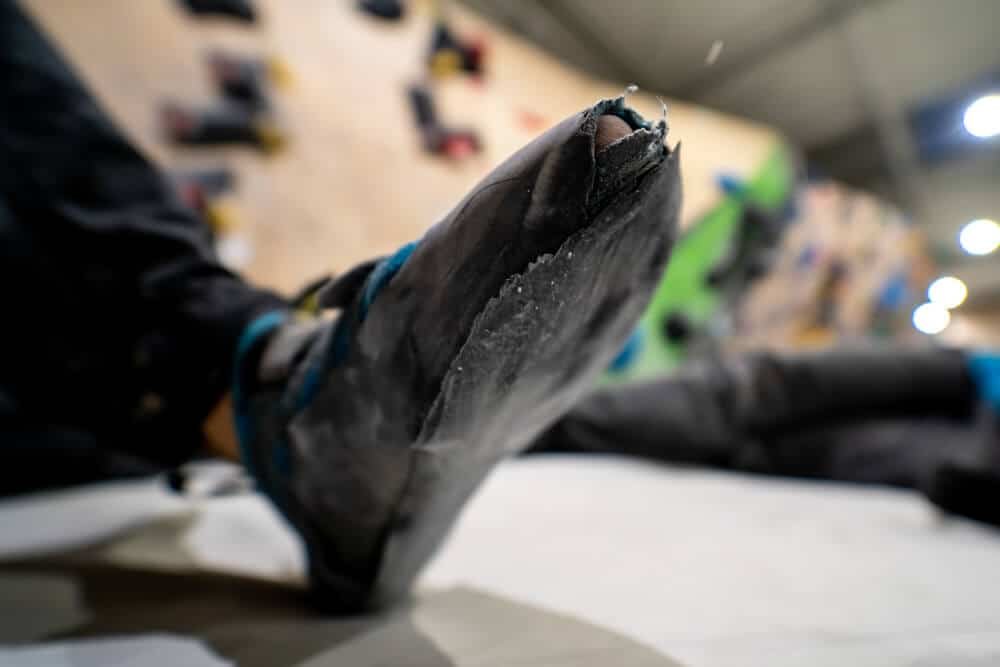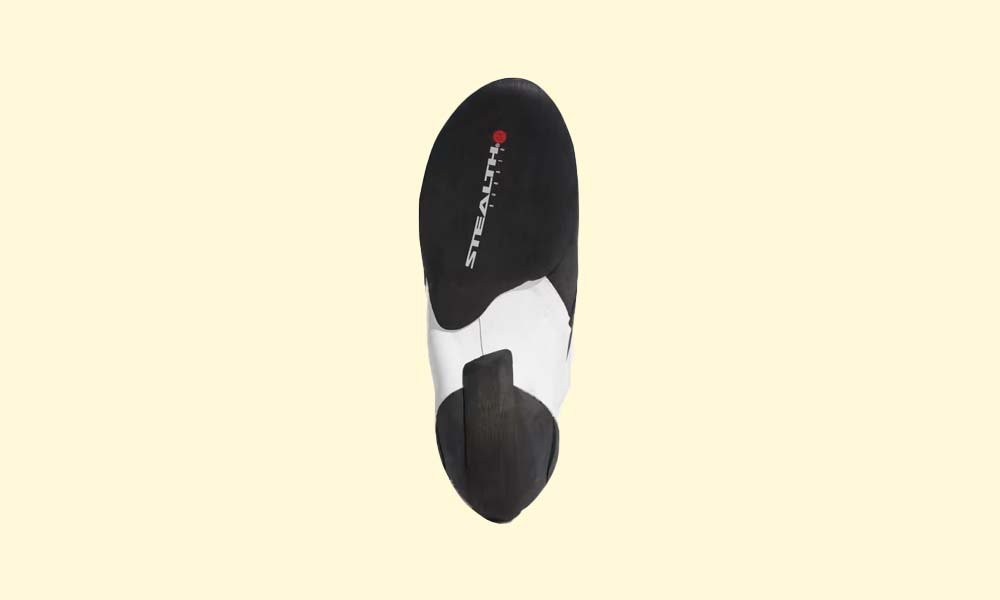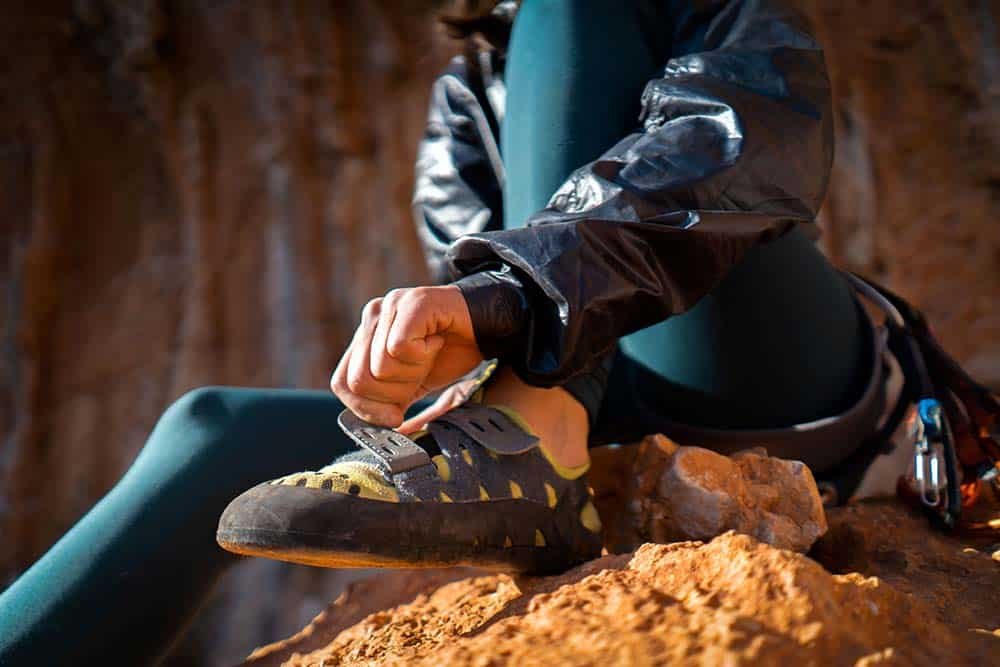Besides your fingertips (and other parts of your limbs if you’re in an off-width), your climbing shoes are the interface between you and the rock. The shoe itself supports your feet, while the sticky rubber in the sole helps you smear and edge with confidence. Without them, you’d be a sweaty, slippery mess.
Unfortunately, the rubberized interface that allows you to stick to the stone like a gecko degrades over time. So what happens then? Do you chuck them in the trash and spend your hard-earned dollars on another pair of exorbitantly expensive climbing shoes? No—not yet. First, you resole them.
Resoling climbing shoes is the ideal way to extend the lifespan of a single pair of climbing shoes. When correctly timed and performed by a skilled cobbler, resoling climbing shoes can add two, if not three, or four lives onto what you thought was a single-use product.
Want to resole your shoes? Keep reading!
Is Resoling Climbing Shoes Worth It?

In my opinion yes, repairing your climbing shoes is worth it. I think it’s worth it for two main reasons.
The first reason revolves around money. Resoling rock climbing shoes is cheaper than replacing your old beat-up shoes with a new pair. Nowadays, with climbing shoes reaching seemingly skyrocketing prices, the argument that resoling is cheaper has never been more true.
I will give you a real-world example from my own life. Just last month, I received three pairs of resoled climbing shoes in the mail from my local cobbler, the Plattsburgh Shoe Hospital. For three pairs of resoled shoes, plus a couple of toe caps, I paid $198.
One of the old shoes was a pair of La Sportiva TC Pros. The regular MSRP for a brand-new pair of TC Pros is over $200. So, for less than the price of one pair of new TC Pros, I got three pairs of resoled climbing shoes that I can wear for at least two to three more seasons.
Are you seeing the picture? To resole is absolutely a better financial decision because you get multiple lifespans out of a single shoe.
Resoling shoes is not only cost-effective. It’s eco-friendly
The second reason why I think resoling shoes is worth it is because it reduces your individual impact on the environment. Without getting too in the weeds about the climbing industry’s negative impacts on the environment, which I think is obvious enough, not to mention your own personal carbon footprint, I’ll just say this– to consume less is better.
In other words, to purchase fewer climbing shoes is better. That’s because by avoiding replacing old shoes with new ones and opting to resole, you participate in a process that requires fewer raw materials, omits less CO2 into the atmosphere, and generally produces less waste.
Do I have the perfect stats to back up that claim? No, I don’t, I admit it. But in the case of satisfying consumeristic tendencies to purchase new shoes, I think it’s obvious that less is more.
Okay, I’ll get off my soap box now. Let’s get back to talking about climbing shoes.
The Components of the Climbing Shoe

I’d like to discuss what exactly cobblers do when they resole a shoe. However, to understand the resole process and its associated jargon, it can be helpful to learn about the shoe itself first. So, let’s get on the same page by going from the heel of the shoe to the toebox.
- Heel rand & heel cup: the heel rand is a piece of rubber that wraps around the back of the shoe, helping provide tension throughout the body of the shoe. The heel cup is the pocket below the heel rand where your heel sits.
- Pull tabs: stitched tabs that are sometimes branded with the manufacturer logo that help you extend the heel rand, open up the heel cup and slip your foot in.
- Tongue: portion of the shoe that sits on top of your foot underneath the closure system that is normally constructed with foam and mesh materials for padding and breathability.
- Closure system: hook-and-loop velcro or lacing closure systems allow you to tighten your shoe and secure your foot inside.
- Upper: the exterior portion of the shoe that is usually made with synthetic materials or leather.
- Midsole: a thin layer of material where your foot comes into contact alongside the bottom of the shoe’s interior. Some climbing shoes feature no midsole, while others feature additional midsole inserts to add rigidity.
- Outsole: the bottom of the climbing shoe that comes in contact with the rock surface and features a special rubber compound to enhance stickiness.
- Rand: rubberized portion of the shoe that wraps around the exterior circumference of the shoe, from the toebox, around the sides of the shoe, all the way to the heel.
What is the Resole Process?

Despite the climbing shoe being a relatively complex piece of equipment with multiple components, the resole process usually only involves the shoe’s outsole and rand.
When you send a pair of climbing shoes in to be resoled, the cobbler will remove half of the old outsole. Specifically, they’ll remove the portion from beneath the forefoot of the shoe. (The sole undearth of the heel portion of the shoe will remain intact).
After they’ve removed half the old sole, they will replace it with a fresh one. Then, they will sculpt the new sole so that it’s similar to a factory-manufactured pair. From there, you have crisp new edges to climb on.
However, more often than not, climbing shoes require additional repairs to the rand along with the outsole. In other words, fresh toe caps are required.
In this case, the cobbler will remove the sole and the rand. First, they will replace the rubber rand. They’ll sculpt the new rand around the toebox of the shoe. This is commonly referred to as a toe cap. Then, they’ll prepare the bottom of the shoe for the new outsole. Once the rand has been repaired, the cobbler will replace the sole.
What Rubber Should I Resole Climbing Shoes With?

One of the fun parts about resoling your climbing shoes is that you can select the rubber that the cobbler uses. Typically, you have two choices.
- Use the same rubber that came stock on the original shoes. (This is what I normally do.)
- Select a different type of rubber. Some folks will try a new type of rubber to change how the shoe feels and climbs.
Rubber type
There are many different types of climbing shoe rubber that are used to resole rock shoes. Each rubber will have unique characteristics. For example, some rubber compounds are known for being harder, while others are softer and more supple. Some examples include:
- Vibram XS Edge: harder and stiffer rubber good for edging
- Vibram XS Grip: a semi-stiff, super versatile rubber compound
- Vibram XS Grip 2: soft rubber that is good for bouldering and steep sport climbing
- UnParalell RH: versatile, all-around rubber with good durability
- Stealth C4: a very soft and sticky rubber compound
Many climbers will choose to resole their shoes with the same rubber that came stock on the shoe. However, if you are curious about a new rubber, try something different! Just remember– the variety of rubber compounds that you can select from will depend on the cobbler.
Rubber thickness
Regardless of the type of rubber you choose, you will also get to decide how thick you want the new soles to be, typically between 3mm and 5mm of rubber. Most commonly, climbers opt for the same rubber thickness that the shoes originally came with.
However, you can also decide to have more or less rubber. A thinner sole will feel more sensitive, which some people enjoy. On the other hand, a thicker sole may lose some sensitivity but be more durable. Ultimately, the decision is up to you.
And if you’re rolling your eyes at “the difference” between a few millimeters of rubber and wonder if that will really impact your climbing, don’t overthink it. Just go with the same sole thickness the shoes came with. If you are unsure of this spec, check the manufacturer’s online store for details.
How Much Does It Cost To Resole Climbing Shoes?

The price for resoling your climbing shoes varies depending on the job. If it’s a simple resole job, where the cobbler is just replacing the outsole of the shoe, then it’ll be pretty affordable. Much more affordable than a new pair of rock shoes.
However, if your climbing shoes are in rough shape, and the repair requires additional add-ons to get them back up and running, like toe caps, then the repair will cost more money. However, even with a series of add-on services or replacement parts, the process normally comes out cheaper than a fresh pair.
Services that will increase the price of your repair.
- Replacing the toe rand with toe caps: replacing toe caps is harder than just doing the sole
- Using specialty rubber: some shoes require special parts, like the La Sportiva Edgeless Outsole Technology for the Futura or the Genius.
- Stitching repair: climbing shoe material can blow out and require additional stitching
- Closure system repair: velcro closure systems are notorious for breaking, so some cobblers will offer repair services
- New laces: most resolers sell replacement parts like new shoe laces
Although the resoling process focuses mostly on the shoe’s rand and outsole, it’s good to know that cobblers are not just resolers. They are shoe cobblers and, therefore, offer other helpful services as well, like fixing stitching, replacing laces, adding patches, and even resoling your approach shoes!
Fallbacks of Resoling Climbing Shoes

Climbing shoe resoling is awesome because you essentially get new shoes, and you get to save money. In my opinion, it’s a win-win situation. But I admit, there are two unfortunate outcomes that come with resoling climbing shoes.
- To resole climbing shoes takes time: wait times for resoled shoes will vary based on your location, the time of year, and the individual cobbler. But from my experience, getting a full resole with some toe caps can take up to three to four weeks, sometimes longer.
- Rand repair can change the the fit and the feel of your shoes: rand repair (adding a toe cap) is notorious for changing how the toebox of the shoe fits your foot and how it feels while rock climbing. This is true even if the cobbler did a really nice job. To avoid this problem, you can repair your soles before getting to the point where additional rand repairs are required.
Tips for Climbing Shoe Resoling

I’ve been climbing for a long time and have had a lot of climbing shoes repaired over the year. Through that process, I’ve learned a lot. So here are some tips.
Plan ahead for the inevitable delay
There are many more climbers than there are cobblers. Therefore, getting your climbing shoes resoled takes time. In addition, besides the actual hands-on time when your shoes are actively being worked on, shoe resoling takes time because of shipping.
So– plan ahead! For example, I get the climbing shoes I wear for guiding resoled during the winter when I am not climbing as much. Then, during the rock season, I resole the shoes I use for gym climbing because I’m hardly using them.
Clean your shoes before shipping
Many resolers will remind you to clean your shoes before shipping them. Heed this warning! If you send your shoes in and they’re chalked up or grimy from your last outdoor trip, they’ll get sent back, you’ll pay more money for shipping costs, and it’ll take even longer.
Get your shoes resoled before the rand rubber explodes
For whatever reason, climbers like to wait until a hole wears through their rand rubber before they consider getting a repair. I recommend not waiting this long! A hole in the rand rubber will require a rand repair, which will cost more money.
If the hole is severely worn, your local resoler may just send them back and advise you to get a brand new pair.
Resoling Your Shoes is the Obviously Correct Decision
I simply do not understand when I see a climber with destroyed rands and blown-out toe boxes. One, it can’t be helpful for their climbing, and two, it’s a waste of money.
Climbing shoes are expensive, so anything you can do to increase their longevity seems like a no-brainer. While you’re using them, keep them clean, let them dry, and store them adequately (i.e., out of direct sunlight).
Throughout their usage, monitor their status. Stay on top of resoles and avoid allowing them to go too far. They’ll perform better for you on the rock, you’ll keep some extra money in your pocket, and you’ll reduce your inevitable impact on the environment.



